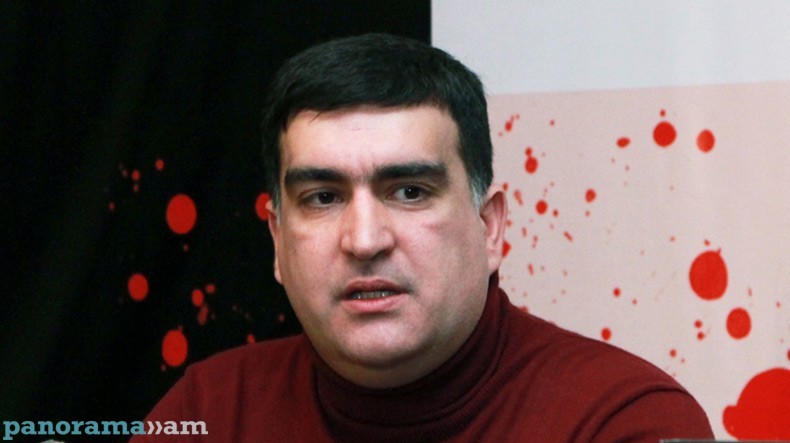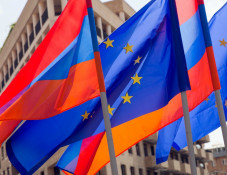
Aris Ghazinyan: Nobody challenged Yerevan’s status as perspective center of Armenian state
The Armenians dispersed around the world worked out various schemes for the salvation of their homeland; they contacted influential diplomats in the hope of convincing them in the necessity of supporting the ancient Christian nation. However, most often, the theory of noble initiatives stumbled against the practice of the regional reality. They had to visit Armenia in order to understand the nature of things. Armenian journalist and researcher Aris Ghazinyan writes about it in his book “Yerevan: with a cross or on the cross,” which is an attempt of setting and considering an extremely diverse range of processes directly or indirectly forming the character of the development of the territory in question and predetermining the inevitability of turning Yerevan into the main center of the Eastern Armenia, and later on into the capital of the recovered Armenian state.
In 1759, 33-year-old Hovsep Emin came to Armenia for the first time expecting to understand the moods of the population, the position of the clergy on recovering the sovereign throne and to contact Artsakh meliks, with whom he originally intended to start military actions. However, the news about the courageous Karabakh monk Avag’s death, who became famous in the meliks’ battles against Panah-khan, made him give up his initial intention of going to Artsakh, where he thought to join Avag, organize a military detachment and go to Georgian king Heraclius to offer services (he had worked out this plan still in England).
The head of the Armenian Church, Hakob V, informed the patriot about the preference of the Russian direction, as well as about the intention of applying to Empress Elizaveta Petrovna for support in the near future, which subsequently took place in July 1760.
As a result, Emin’s contacts with influential Russian politicians intensified Petersburg’s interest in the Armenian factor and laid the foundation for a new, “Catherinian Era” in the negotiations between Armenian and Russian activists.
When Emin was offered to stay for serving in Russia, he answered that he had left India and gone to Europe only because he wanted to help his compatriots, and that he was the person Peter the Great needed for liberating the Armenians. Emin also said that if Russia were in a war with Turkey, he would have joined it and fought against the Ottoman Empire without a second thought, but now he preferred to act in a different way, as there was no war.
Meanwhile, Yerevan-born Simeon ascended the patriarchal throne a year after the accession of Empress Catherine II in Russia and after the proclamation of the united Kingdom of Kartli-Kakheti by the monk Heraclius II. Ghazinyan writes that accordingly, Catholicos Simeon Yerevantsi’s period of activities set favourable grounds for conducting an active national policy.
According to Ghazinyan, he was sure that the establishment of a viable state was impossible without the oppression of demographic positions of the alien element, which was intensively reproducing itself. Being dispersed, it had always – throughout all the previous centuries – reminded of itself with political ambitions of its leaders from different races.
The Catholicos’ activities were entirely directed towards selecting a “joint Armenian potential,” towards upbringing such a generation of the Ararat Armenians, which would be able to demonstrate its ability of “not being confused in crucial upheavals,” of foreseeing “the history’s tomorrow” and even of bringing it closer to itself. In this context, the Catholicos gave a huge importance to the policy on the prevention of assimilation, which was carried out not only by inclining the Armenians to Islam, but also by forcing them to adopt Catholicism, or Russian Orthodoxy in the territory of the Russian Empire (during Elizaveta Petrovna’s reign).
“Therefore, Simeon’s entire activity was concentrated on gathering the all-Armenian resource, and, more importantly, on the cultivation and upbringing of a new Ararat generation, which would be able to competently orient in the international time and national space,” Ghazinyan summarizes.
The activation of Orthodox Russian Empire’s eastern policy settled great hopes of salvation from the Muslim oppression in the hearts of enslaved Christian nations. The 6-year-long Russo-Turkish War (1768–1774) in the period of Catherine the Great’s reign ended with the Ottoman Empire’s defeat; as a result, according to 1774 Kucuk Kaynarca treaty, Armenian interests were not touched.
“On June 8, 1769, a project on the liberation of the Armenian regions from the Ottoman and Persian yoke and the recovery of the Armenian state under Russia’s protectorate was presented to the Collegium of Foreign Affairs. The author of the project was Persian-born Moisey Sarafov (Movses Sarafyan), the owner of the Astrakhan Silk Factory. He soon occupied a prominent position among the Armenian merchants in Astrakhan.”
In the report letter, Sarafov offered to start military action with establishing control over Yerevan, which “has a crucial strategic significance and it is extremely important for the Russian troops to have that fortress in their hands as a basis for the development of the operation against Turkey.”
According to the project, following Yerevan’s liberation, joint military action against the Ottoman Empire organized by the Russian Expeditionary Force, Georgian troops, and Armenian detachments should start. Particularly, Georgian king Heraclius would start the military action by attacking the nearby fortresses Akhaltsikhe and Kars, the Armenian volunteers together with the Russian army would come out from Yerevan, attack Bayazit, then Van, “then, if God helps, it will enter everywhere it can.”
“Yerevan would be named the capital of the recovered Kingdom of Greater Armenia already during the subsequent years, in the period of the negotiation processes between Russian politicians and Armenian public figures,” Ghazinyan wrties.
The negotiation process between the Russian military-political circles and Armenian delegations started immediately after the war, when Catherine the Great’s government approved the plan of Russian troops’ campaign to the Western Transcaucasia, a fact, which encountered a tremendous response among the Armenians. The campaign’s preparation and implementation were assigned to the prominent commander Alexander Vasilyevich Suvorov.
On January 1, 1780, Alexander Suvorov, Ivan Gorich, and Grigory Potemkin met in Petersburg and talked to Archbishop Joseph Argutinsky-Dolgorukov and Ivan Lazarev, who had a considerable authority at the court of Catherine II. The question of the Armenian kingdom’s recovery with capital Yerevan was also discussed on January 3 with Potemkin; there is a record about it in archbishop Argutinsky’s diary.
At that time, in January 1780, Suvorov received a report about Armenia’s political condition and measures on recovering the Armenian state. It was particularly noted in the report that Armenia was emptied; part of its population had been forcedly resettled in different places, however, Armenian meliks in Karabakh still maintained their independence and were ready to advance their troops if necessary. For the recovery of the Armenian kingdom, it was necessary to have Russia’s military and economic support and to organize a military campaign against Yerevan.
Ghazinyan notes that in 1787, a new Russo-Turkish war started, in which the Ottoman Empire was again defeated. “In the middle of the 18th century, certain changes took place in the outlined tendency. They were conditioned by two factors: the downfall of the Zendian dynasty of Persia in 1795 and Turkic Qajar dynasty’s accession to the throne, and the death of the Empress Catherine II in 1796,” Ghazinyan writes.
In 1785, as a result of a treason, the Qajars captured the Zendian capital Isfahan and according to a contemporary, ruined it in a way “the city had not experienced ever before, even during the Afghan invasion.” “The new dynasty’s accession to the throne marked the start of a process of cardinal curtailment of the viceroyalties’ autonomous powers and had a most immediate effect on the prospects of Yerevan (Irevan) khanate’s development: Turkic governors of Yerevan turned into unconditional vassals of the metropolis. Agha Mohammad Khan Qajar became the founder of the new dynasty uniting Persia and making Tehran its capital,” Ghazinyan writes.
In 1975, he came out against Georgia on the pretext of its alliance with Russia. Beating the army of the king Heraclius II in the battle of Krtsanisi, he victoriously entered into Tiflis and fully destroyed the city and slaughtered tens of thousands of inhabitants. Armenian poet and musician Sayat-Nova was among them.
“Agha Mohammad Khan proclaimed himself the shah of Persia months later, and in 1797, he came out against Russia and defeated Valerian Zubov’s detachment (the latter had already been recalled by the order of the new emperor Paul I). Later, Mohammad Khan decided to ‘go through Georgia again,’ but was killed in Shushi, Karabakh,” Ghazinyan informs.
In February 1801, a Manifesto on Georgia’s “perpetual” joining to Russia was read out in the Sioni Cathedral, and already in February, the manifesto was solemnly proclaimed in the Tiflis Cathedral. “In March 1801, Alexander I ascended the throne of the Russian Empire, and he had to immediately solve the question related to the joining. It was a painful process crowned, as a result, by the inclusion of Georgia and northern lands of Armenia in the Russian Empire. This was how the 19th century started: it was obvious that the Russo-Persian War was just around the corner,” Ghazinyan writes.
Related news
Newsfeed
Videos






























